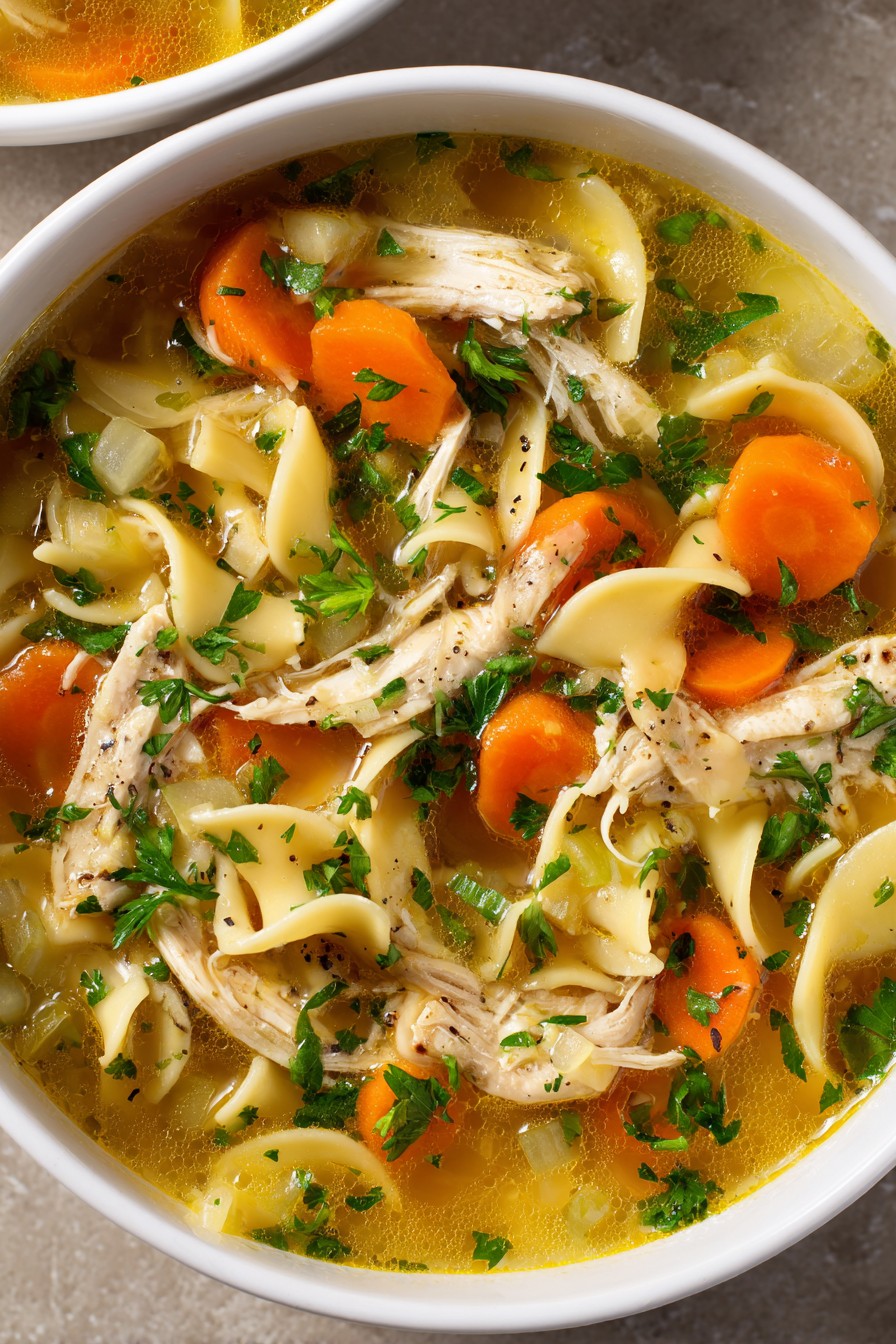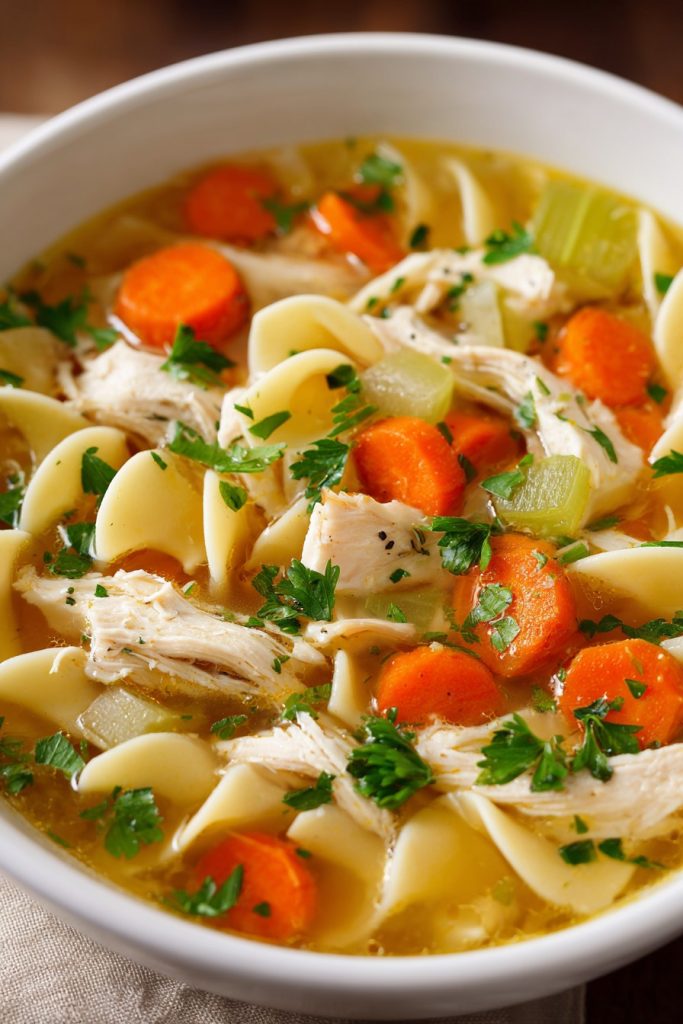Crafting a delicious low sodium chicken noodle soup doesn’t mean sacrificing flavor or that cozy, homemade feel. Comfort food can absolutely be both heart-healthy and utterly satisfying, and this recipe proves it with every savory spoonful. Consider this your new go-to for chilly evenings, sick days, or anytime you crave a bowl of pure comfort without the salt overload.
Why This Recipe Works
- By using a combination of fresh herbs like thyme, rosemary, and parsley, we build layers of flavor that compensate beautifully for reduced salt, ensuring each bite is aromatic and deeply satisfying.
- Roasting the chicken thighs first unlocks rich, caramelized notes and creates a flavorful base for the broth, adding depth that store-bought broths or boiled chicken simply can’t match.
- Sautéing the onions, carrots, and celery until they’re tender and slightly golden develops their natural sweetness, which enhances the overall taste profile and makes the soup feel more robust and homemade.
- Simmering the soup gently after adding the noodles allows them to cook perfectly al dente while absorbing the herb-infused broth, preventing them from becoming mushy and ensuring a pleasing texture in every spoonful.
- Finishing with a squeeze of fresh lemon juice just before serving brightens all the flavors, adding a subtle zing that makes the soup taste fresher and more balanced without any need for extra salt.
Ingredients
- 1.5 pounds boneless, skinless chicken thighs, patted dry
- 2 tablespoons olive oil, divided
- 1 large yellow onion, finely diced
- 3 medium carrots, peeled and sliced into 1/4-inch rounds
- 3 celery stalks, finely chopped
- 4 cloves garlic, minced
- 8 cups low sodium chicken broth
- 2 bay leaves
- 1 teaspoon dried thyme
- 1/2 teaspoon dried rosemary
- 1/2 teaspoon black pepper, freshly ground
- 8 ounces wide egg noodles
- 1/4 cup fresh parsley, finely chopped
- 1 tablespoon fresh lemon juice
Equipment Needed
- Large Dutch oven or heavy-bottomed pot
- Rimmed baking sheet
- Chef’s knife and cutting board
- Measuring cups and spoons
- Tongs
- Ladle
Instructions

Preheat and Roast the Chicken
Preheat your oven to 400°F. Place the chicken thighs on a rimmed baking sheet and drizzle with 1 tablespoon of olive oil, rubbing it evenly over both sides. Roast for 20-25 minutes, flipping halfway through, until the internal temperature reaches 165°F and the edges are golden brown. Remove from the oven and let them rest for 5 minutes before shredding into bite-sized pieces using two forks. This initial roasting step is crucial because it develops a deeper, richer flavor in the chicken that will infuse the entire soup, making it taste far more complex than if you boiled or sautéed the chicken. Plus, those little crispy bits add wonderful texture.
Sauté the Aromatics and Vegetables
Heat the remaining 1 tablespoon of olive oil in your large Dutch oven over medium heat. Add the diced onion, sliced carrots, and chopped celery, stirring occasionally. Cook for 8-10 minutes until the vegetables have softened and the onions become translucent, with the carrots showing a slight brightening in color. Add the minced garlic and cook for another 60 seconds, just until fragrant. This step is where you build the foundation of flavor; taking the time to sauté properly ensures the vegetables release their natural sugars, which caramelize slightly and add a subtle sweetness that balances the herbs and broth beautifully.
Simmer the Broth with Herbs
Pour in the low sodium chicken broth, then add the bay leaves, dried thyme, dried rosemary, and black pepper. Bring the mixture to a gentle boil over high heat, then immediately reduce the heat to low, cover the pot, and let it simmer for 15 minutes. You should see small bubbles steadily rising to the surface but not a rolling boil. This gentle simmer allows the herbs to fully infuse the broth, creating a fragrant, flavorful base without any harshness. Tip: If you have fresh herbs on hand, tie them into a bundle with kitchen twine for easy removal later.
Add Noodles and Shredded Chicken
Finish and Serve the Soup
Remove the pot from the heat and discard the bay leaves. Stir in the fresh parsley and lemon juice, tasting the soup to see if it needs any adjustment (though remember, it’s low sodium, so embrace the natural flavors!). Let it sit uncovered for 2-3 minutes to allow the parsley to wilt slightly and the lemon juice to meld with the broth. Ladle into bowls and serve immediately while hot. The lemon juice at the end is a game-changer—it brightens all the flavors and adds a refreshing note that makes the soup feel lighter and more vibrant.
Tips and Tricks
If you’re really watching your sodium intake, consider making your own low sodium chicken broth from scratch. Simmer chicken bones with vegetables like onions, carrots, and celery, along with herbs like parsley and thyme, for several hours. Strain and cool it, then skim off any fat that rises to the top. Homemade broth not only lets you control the salt level completely but also has a richer, more authentic flavor than store-bought versions. Another advanced tip: toast your dried herbs lightly in a dry skillet for about 30 seconds before adding them to the soup. This quick step wakes up their essential oils and intensifies their aroma, giving you more bang for your herb buck without any extra salt. For an even deeper flavor, try roasting the vegetables instead of sautéing them. Toss the onions, carrots, and celery with a bit of olive oil and spread them on a baking sheet. Roast at 400°F for 20-25 minutes until they’re caramelized and tender, then proceed with the recipe. This adds a smoky, sweet complexity that makes the soup taste like it simmered for hours. If you prefer a clearer broth, consider straining the soup after simmering the herbs and before adding the noodles and chicken. Simply pour it through a fine-mesh sieve to remove any vegetable bits or herb fragments, then return the liquid to the pot and continue. This gives you a beautifully clear broth that’s still packed with flavor. Lastly, if you’re meal prepping, cook the noodles separately and add them to individual bowls when serving. This prevents them from becoming mushy and absorbing too much liquid when stored, keeping your soup fresh and textured for days.
Recipe Variations
- For a gluten-free version, swap the egg noodles with an equal amount of gluten-free pasta like brown rice noodles or quinoa noodles. Cook them separately according to package directions to avoid them breaking down in the soup, then add them just before serving to maintain their texture and integrity.
- Add more vegetables like 1 cup of chopped kale or spinach stirred in during the last 2 minutes of cooking, or 1 cup of frozen peas added along with the noodles. These bring extra color, nutrients, and a slight variation in texture that makes the soup feel even heartier and more customized to your taste.
- Make it creamy by stirring in 1/2 cup of plain Greek yogurt or coconut milk at the very end, after removing the soup from heat. This adds a luxurious, velvety texture and a tangy or mildly sweet note that complements the herbs beautifully without overpowering the low sodium profile.
- Spice it up with a pinch of red pepper flakes added when sautéing the vegetables, or a dash of hot sauce stirred in at the end. This gives the soup a gentle kick that wakes up the palate and adds an exciting layer of heat, perfect for those who enjoy a bit of warmth in their comfort food.
- Turn it into a lemon-herb delight by doubling the amount of fresh lemon juice and adding extra fresh herbs like dill or chives along with the parsley. This variation emphasizes brightness and freshness, making the soup feel lighter and more rejuvenating, ideal for spring or summer days when you still want something comforting but not too heavy.
Frequently Asked Questions
Can I use chicken breast instead of thighs in this low sodium soup? Absolutely! Chicken breast works well, but since it’s leaner, it can dry out more easily. To keep it tender, reduce the roasting time to 15-20 minutes and check that the internal temperature hits 165°F. Shred it immediately after resting to lock in juices. Thighs are recommended for their richer flavor and moisture, but breast is a great lower-fat option that still tastes delicious when not overcooked.
How long does this soup last in the refrigerator, and can I freeze it? Stored in an airtight container, it keeps well for 3-4 days in the fridge. For freezing, omit the noodles and add them fresh when reheating, as they tend to become mushy after thawing. Freeze the broth, chicken, and vegetables for up to 3 months. Thaw overnight in the refrigerator, reheat on the stove, and cook noodles separately to add in for the best texture.
What can I use if I don’t have low sodium chicken broth on hand? No worries! Use regular chicken broth and dilute it with an equal amount of water to reduce the sodium content. Alternatively, you can make a quick broth by simmering water with onion, carrot, celery, and herbs for 20 minutes, then straining it. This DIY approach lets you control salt completely and still gives a flavorful base for your soup.
Is this soup suitable for a low-carb or keto diet? With the noodles, it’s not low-carb, but you can easily adapt it. Replace the egg noodles with zucchini noodles (zoodles) or shirataki noodles. Add them in the last 2-3 minutes of cooking just to heat through, avoiding sogginess. This swap keeps the carb count low while maintaining that comforting soup feel, perfect for keto followers.
Summary
This low sodium chicken noodle soup delivers all the comfort of the classic with clever herb and technique twists for big flavor. Perfect for health-conscious food lovers craving a hearty, homemade bowl without the salt overload.
Low Sodium Chicken Noodle Soup
4
servings15
minutes50
minutesIngredients
Instructions
- 1 Preheat oven to 400°F. Roast chicken thighs with 1 tbsp olive oil for 20-25 minutes until 165°F internally, then shred.
- 2 In a Dutch oven, heat remaining oil over medium heat. Sauté onion, carrots, and celery for 8-10 minutes until softened. Add garlic and cook for 1 minute.
- 3 Add broth, bay leaves, thyme, rosemary, and pepper. Bring to a boil, then simmer covered for 15 minutes.
- 4 Stir in noodles and shredded chicken. Simmer covered for 8-10 minutes until noodles are al dente.
- 5 Remove from heat. Discard bay leaves, stir in parsley and lemon juice, and let sit for 2-3 minutes before serving.



